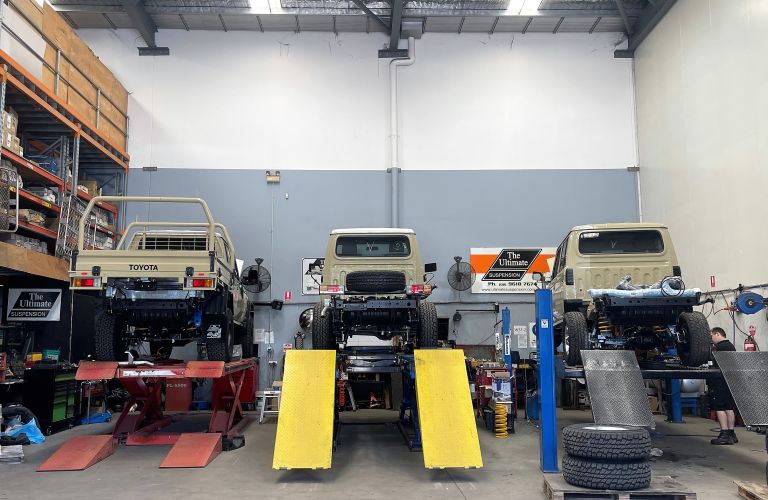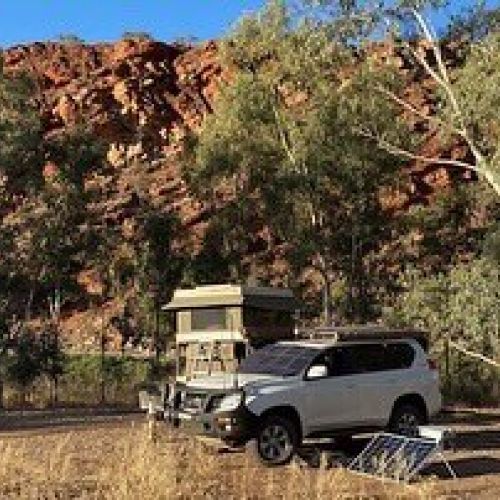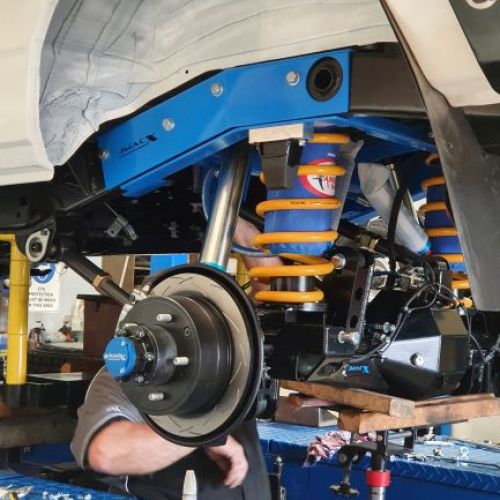Definitions:
Gross Vehicle Mass (GVM)
GVM is the maximum a vehicle can weigh when fully loaded. This includes the vehicle, all of its luggage, fuel, accessories and passengers. It is specified by the vehicle manufacturer on a plate affixed to the vehicle.
Gross Combination Mass (GCM)
GCM is the greatest possible sum of the maximum loaded mass of a motor vehicle, and any vehicles that may be lawfully towed by it at one time. The GCM on a passenger vehicle is not stamped on any compliance plates - it is specified in the owners manual or upon request from the manufacturer to disclose.
Braked Towing Capacity (BTC)
BTC is determined by the vehicle manufacturer and is based on factors such as the design of the vehicle, the vehicle's rear axle load, the capacity of its tyres and the effect the fully loaded trailer will have on the vehicle's stability, durability and general safety.
Tow Ball Weight (TBW)
TBW is the downward force from the a-frame of the caravan/trailer which when connected is applied to the vehicles tow bar.
Aggregate Trailer Mass (ATM)
ATM is the combined weight of the trailer and its full load when it is not coupled to a tow vehicle.
How do I calculate GVM?
GVM for any vehicle is calculated as the total weight of the vehicle while allowing for all fluids of the vehicle with 80kg per passenger. This means that if your new Hilux comes it at 2800kg with a full tank of fuel and no passengers, your a legally over your GVM by 200kg!
How do you build the right set up for my vehicle?
Suspension set up is relative to weight. Don't settle for a one size fits all approach for your vehicle's needs. You CAN get an excellent riding vehicle at an affordable price. Click here to know more about our Ultimate Process. Call us now for a free quote.
Am I over GVM?
Stop the guess work and get your vehicle weighed! Click here
I need my vehicle inspected and engineered, what is the process?
Give us a call to book in your appointment for an initial consultation.
I have a custom application, can you build something for me?
Sure. Give us a call and if we can't help, then we'll refer you onto somebody who can!
Do you fit accessories?
Yes. Our team are not only certified mechanics but can also set up your bull bars, snorkel, roof racks and can build your 12V dream. Our approach is meticulous and we pride ourselves in our attention to detail. We can fabricate anything you can dream of and can make it happen. Our fierce independence and our experience of 45 years in the industry means we can source any brand that you have your heart set on.
I live in another state, can I still get your products?
Yes. Give us a call and we can deliver our great products anywhere around the country - and FAST!
I live overseas, can I still get your products?
Yes. We're sending goods overseas almost every week. So if you have a destination, we can definitely get it there.
Has there been a recent change to the law regulating pre-registration GCM upgrades?
There has been no recent change to the law regulating pre-registration vehicle upgrades.
Lovells understands that the longstanding position for many years has been that while the Federal Department does not assess, endorse or approve GCM upgrades, it equally does not restrict or prohibit GCM upgrades. Lovells understands this longstanding position has not changed.
Importantly, this means that:
Vehicles that Lovells has previously modified are legal in all States and Territories.
Lovells is permitted to plate vehicles with gross vehicle mass (GVM) upgrades and towing capacity upgrades under the approved RVD (as stated in Lovells SSM approvals and as noted on current RVDs).
Lovells is permitted to modify GVM/GCM/towing capacity or variants of these modifications in all States and Territories prior to first registration.
What is the position regarding post-registration upgrades?
When a manufacturer modifies a vehicle that has already been registered, this modification is governed by the various State and Territory authorities and their individual Type Approvals or Modification Codes. Put simply, these upgrades are governed by State and Territory law.
Whether a particular type of modification is available post-registration, therefore depends on the position in the State or Territory in question. Some of the States and Territories have recently changed their position in relation to post-registration upgrades.
GCM upgrades post-registration
Lovells understands that the current position in relation to GCM upgrades in each State and Territory is as follows:
NSW, SA and VIC recognise a revised GCM specified by a SSM if endorsed by the inspecting engineering signatory. The signatory must be an endorsed engineer who has access to our Evidence Packages. Endorsed engineers’ contact details are available upon request.
Tasmania recognises a revised GCM specified by a SSM.
Queensland no longer recognises a revised GCM above the GCM nominated by the OEM. However, on 22 January 2020, Queensland TMR released a statement to the industry that “TMR is exploring options for the issue of a new code that deals with GCM increases. TMR is working closely with Industry on this task, and in particular the Australian Automotive Aftermarket Association (AAAA). Whilst TMR’s priority remains on road safety and national consistency, it is optimistic that a technically sound and separate code-based solution for GCM re-rating can be developed”.
WA, ACT and NT no longer recognises a revised GCM above the GCM nominated by the OEM if the vehicle is modified after first registration.
Is the GCM Upgraded and is the ANCAP Rating Affected?
Note that The GCM (Gross Combined Mass) is not noted on our Second Stage of Manufacture RVD (Road Vehicle Descriptor) nor is GCM noted on the Original Equipment Manufacturers RVD. A GCM figure is also not noted on any OE or SSM Federal Compliance plate, however the figure is usually gazetted or published in handbooks, owner’s manuals, sales brochures or specification sheets.
Lovells RVD (Road Vehicle Descriptor) for each SSM IPA (Identification Plate Approval) notes the New Lovells GVM Capacity and the Maximum Braked Towing Capacity. As a Second Stage Manufacturer, Lovells publish a new GCM Capacity for the vehicle, as we accept responsibility for compliance with the ADRs in relation to that vehicle and are issued a compliance plate approval certificate for that vehicle. As a Second Stage Manufacturer, it is Lovells responsibility to document all applicable ADR tests and compile evidence packages for critical vehicle components, handling, stability, thermal dynamics of powertrain and drivetrain, chassis and mechanical connections and thus take responsibility and liability for the GVM upgrade compliance, increased axle capacities, towing capacities and GCM revisions.
We note that Lovells increase and list new Axle Loading Capacities for each vehicle based on stringent test data and FEA evidence.
The Original Equipment maximum braked towing capacity for example on the Toyota Landcruiser LC200 is 3500kg. This doesn’t increase nor decrease when a Lovells GVM Upgrade is fitted, it remains at 3500kg.
The new vehicle GVM becomes 3800kg (LC200) as noted in Lovells SSM (Second Stage of Manufacture for GVM Upgrade)
The factor that comes into play is the ball weight of the towed apparatus. Whatever the ball weight is, must be subtracted from the vehicles GVM and GCM.
Therefore, the vehicle can still tow up to OE 3500kg. If the ball weight is 200kg, the vehicle’s maximum available GVM (with a Lovells GVM Upgrade kit fitted) will now be 3600kg for the LC200.
Whereas, when a Lovells 4,000kg BTC Upgrade is fitted, the vehicle can then tow up to 4000kg. Yet, if the ball weight remains at 200kg, the vehicle’s maximum available GVM (with a Lovells GVM Upgrade kit fitted) will still be 3600kg for the LC200).
Pre-registration GCM upgrades
A vehicle’s GCM is first nominated by the original manufacturer (OEM).
There are various organisations, known in the industry as ‘second stage manufacturers’ (SSMs), that are frequently engaged to upgrade vehicle capacity, prior to first registration. Some SSMs, like Lovells, update the GCM to reflect the change in capacity as a result of the upgrade.
Lovells believes that when there has been an upgrade to vehicle capacity pre-registration, it is important for any change to the vehicle’s GCM that has resulted from the upgrade to be noted. Lovells believes this is important for numerous reasons, including for accuracy and safety.
Lovells understands that an updated GCM may be specified by a manufacturer and believes it is good practice for manufacturers to do so.
Is the GVM and BTC upgrade legal in all States and Territories?
Yes. Rest assured, the Federal Department of Transport have the final say on all Second-Stage Manufacturers Approvals and we cover everything and more as required by the ADRs.




